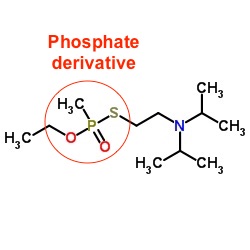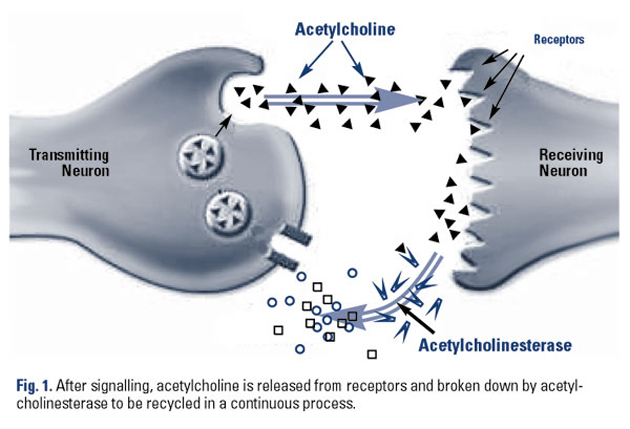Initial reports suggest that Kim Jong-Nam, the estranged half-brother of North Korean dictator Kim Jong-Un, was murdered with VX, a type of agent used in chemical warfare. What is it, and how does it work?
VX is an organophosphate, a generic name for any molecular compound that contains carbon and phosphate (i.e., ions made of phosphorus and oxygen atoms). Organophosphates are found everywhere. Life-giving molecules like DNA are organophosphates, but so are some pesticides and nerve agents. Given the structure of VX (which includes a sulfur atom), it is more specifically a phosphonothioate. (See image on right.)
VX can either be inhaled or absorbed. A single drop on the skin can be lethal because it is one of the most toxic  chemical warfare agents known. The lethal dose (specifically, a measure called the LD50) may be as tiny as 0.04 mg/kg, according to a report prepared for the National Academies. A 70-kg man, therefore, could be killed by as little as 2.8 mg of VX. (For comparison, the lethal dose of fentanyl, the compound blamed for the opioid overdose epidemic, is about 3 mg.)
chemical warfare agents known. The lethal dose (specifically, a measure called the LD50) may be as tiny as 0.04 mg/kg, according to a report prepared for the National Academies. A 70-kg man, therefore, could be killed by as little as 2.8 mg of VX. (For comparison, the lethal dose of fentanyl, the compound blamed for the opioid overdose epidemic, is about 3 mg.)
The woman who is thought to have poisoned Kim Jong-Nam is quite lucky to be alive. A video depicts her shoving her hands into Mr. Kim's face. She must be wearing gloves or some sort of skin protection. Similarly, the people who came into contact with Mr. Kim following his exposure are also lucky to escape the incident unharmed.
How VX Works
VX kills because it is a nerve agent. Specifically, it interferes with an important neurotransmitter called acetylcholine. During normal physiological processes, nerve signals are transmitted from one neuron to another. When the signal reaches the end of the transmitting neuron, the cell releases acetylcholine, which then attaches to receptors on receiving neurons. After its work is finished, an enzyme called acetylcholinesterase recycles the acetylcholine. (See below.)

The recycling (i.e., chemical breakdown) of acetylcholine is vitally important. If acetylcholine persists, very bad things happen, such as vomiting, diarrhea, seizures, and paralysis. Respiratory failure is the likely cause of death.
Molecular Mechanism of VX
VX works, in part, because it is very similar in molecular structure to acetylcholine. (See below.)

Source: Purdue University
VX attacks the enzyme acetylcholinesterase. The phosphorus atom binds to the enzyme and doesn't let go, destroying it. The enzyme is no longer able to function. Acetylcholine builds up, causing the symptoms described above.
An Antidote to VX
Atropine is an antidote to poisoning with VX. However, it must be administered quickly. Since VX poisoning is very uncommon, it is not likely any medical professional would have been able to identify the problem to act fast enough to save Mr. Kim. Of course, that was precisely Kim Jong-Un's intention.




